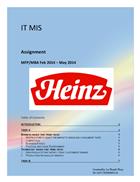




Mã tài liệu: 643471
Số trang: 16
Định dạng: docx
Dung lượng file: 6,373 Kb
Chuyên mục: Kinh tế
Introduction Being founded by Henry John Heinz in 1869, Heinz is one of the few food companies in the world that are considered truly successful. It is not the type of company that becomes the subject that stirring the stock market and being lauded on the front page of the newspaper but then disappears a few years later. The company has stably been well-performed. The market share of Heinz outside the US is recorded at sixty percent of its sales (Heinz 10K Annual Report). There are three main categories of product that Heinz focuses on includes condiments, frozen foods, and infant foods. Its products are recognised through out the world. Heinz manufacture processes and its products are acknowledged to meet the standards of all countries that Heinz presents, and also satisfies various demand of consumers as well. Heinz’s innovative marketing techniques are the key to its success in the global food industry. Heinz divides its markets into the five regions of North America, U.S. Foodservice, Europe, Asia/Pacific and Rest of World. Task A Business issues that Heinz faces The reputation of tomato sauce Heinz is like the supreme position in which no one can touch it, however it does not mean that it encounter no obstacles. The sauce "scare salsa", together with tomato sauce, are reported to alternately held the position of number one condiment in America. 1. Restructure to adapt the market’s needs and consumers’ taste Since being founded, Heinz has dominated ketchup market (revenue in 2005 reached 267.1 million USD) and accounted for 60% of this commodity category’s market. Tomato sauce Hunt stands in second place, followed closely with 16% market share during the same period, while Del Monte’s market share is just big enough to create a small bright spot in the market with 5.3% market share - falling behind others private brands that, together, share 17% market. Not only Heinz but other large companies also had to gather their management boards at a table to review product categories, priorities and potential of their marketing, only to discover that it is a really difficult task to reform and restructure the company. After all, what marketers want to do is to see new opportunities and figure out how to capture them. Many companies had significant changes in their structure since 2007. Let take Lego and Gillette as examples. These companies, which operate in organizational structure, have begun to allow local units to be more flexible. Companies such as Nestlé or Electrolux, in the past has taken a decentralized approach, claiming that they are doing quite opposite to Lego or Gillette. Indeed, the distinction between structure and culture is becoming increasingly blurred. This is usually a laborious process. Persuading senior managers, who have long term experience with their position, in each country to change their way of thinking is all that truly matters. But Heinz has done that. Currently, after the implementation of structural reforms, the company has a stable performance. In the UK, items as baked beans, tomato sauce and soup branded companies have strong positions. Sale revenue in 2000 is about 530 million pounds in the UK, accounting for more than revenue in the rest of Europe combined. Italy is the second largest market, with sales roughly a third of Heinz UK’s revenue in the same year. 2. Competition Despite the failure to expand its brand and to face competition from the spicy food affected by cultural understandings, Smith did not see the rapid decline of species present in tomato sauce at any time. He said "There are so many designers in the area of ketchup. If I walked into tasty food stores in New York, I would find 10 or 15 different sauces. There are not just the 3 basic types. Restaurants also serve fresh sauces that are truly fresh. This represents the diversity of types - here is an interesting field and requires no slow growth. " There is also an international market for spices. In other countries, according to the document of Smith, the tomato sauce is used for anything from Pasta (Netherlands and Venezuela) to cabbage rolls (Japan), meatballs, fish balls (Sweden). The formula may be different, depending on the locality. They create changes based on consumer preferences in each place. With the attraction of international markets, ketchup is on track to become a special component for great meals instead of becoming the panacea of boring meals. Like salt, mustard and sauces are suffering bad rumours around in the gourmet world that makes Heinz to look back. 3. Business Ethics Towards innovation, Heinz is supposed to take business ethics into its consideration seriously. There main ethics issue that the company will have to tackle when undergoing changes is the employees’ belief. They would not find it necessary for the business to be restructured because the current system has already been applied for a long period of time so that it enables them to handle their work smoothly. Furthermore, applying new technology or production techniques or equipment would take time to train workers on how to use them correctly and also take time for them to gain necessary skills to operating them. 4. Political and Legal Environment Laws and Regulation greatly impact the performance of a company in the country it is operating. They could be regulations that conduct changes in food and drug laws, environmental laws, and taxation, accounting standards. There are a number of legal factors that are considered to affect negatively to financial activity of the company. They are supply chain disruption, fees related to production cost, transportation or distribution, labour expenses, food safety standards and so on.
Những tài liệu gần giống với tài liệu bạn đang xem
Những tài liệu bạn đã xem
 Information technology management
Introduction Being founded by Henry John Heinz in 1869, Heinz is one of the few food companies in the world that are considered truly successful. It is not the type of company that becomes the subject that stirring the stock market and being lauded
docx Đăng bởi
428228
Information technology management
Introduction Being founded by Henry John Heinz in 1869, Heinz is one of the few food companies in the world that are considered truly successful. It is not the type of company that becomes the subject that stirring the stock market and being lauded
docx Đăng bởi
428228